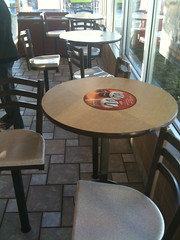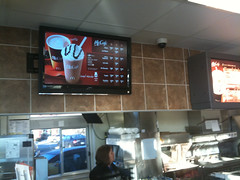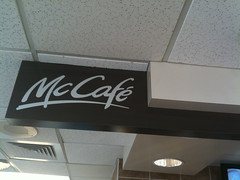In the past couple of years, have you noticed how many fast food chain restaurants have undergone a complete facelift? This is a photograph, taken with the Pano application on my iPhone, of our Oklahoma City KFC restaurant on 23rd street. Wow! What a change from the “typical” fast food restaurant!
The physical environment has been altered dramatically in several of the McDonalds restaurants in our area as well. Booths and traditional tables have been replaced, in areas, to bar stools and small tables.
Boring, functional lights have been replaced with trendy lights that remind me of Starbucks or Pottery Barn.
The marketing messages and service focus of McDonalds has changed fundamentally as well. Instead of the traditional, “Big Mac and fries for everyone,” now the emphasis is on “drinks made to order.”
Flat screen televisions now adorn the walls, showing product prices and (in some stores) live television like CNN.
If McDonalds can re-invent itself as the “McCafe,” what about our schools?
I share the frustration of many others at the complete LACK of change we’ve seen in U.S. educational policy under the leadership of President Obama. I wonder if our political leaders see any alternative to the current recipe of high-stakes accountability, threats, and coercion to force states to open the coffers of public education dollars to private interests?
If McDonalds and KFC can reinvent themselves, why can’t our schools? Thankfully our K-12 public schools are not businesses (yet) where money and profits are the bottom line for all decision-making… but I keep coming back to the idea that the ECONOMICS underlying the way our schools are funded needs fundamental change. Where is the incentive to change in our public schools? Everywhere I’ve heard about innovative charter schools finding success, I’ve seen and heard about “regular” public school educators and leaders who see those successes as a big NEGATIVE and a threat which needs to be eliminated, rather than a successful model which could be replicated. Here in Oklahoma, the court case started by Tulsa Public Schools against our state charter school law (which only permits charter schools in TWO districts, our largest, Oklahoma City and Tulsa) was finally dropped. Public educators in so many places seem hell-bent to kill charter schools, which threaten to siphon off much-needed funding for public schools. Some of the most innovative schools we see are charter schools (as well as rural schools,) but these schools are almost never seen as “possible models” by most schools, particularly large urban ones. Where are the prospects for change in this environment?
I don’t have the answers.
Technorati Tags:
change, creative, creativity, design, education, innovation, leadership, reform, school, mcdonalds, kfc, charter
If you enjoyed this post and found it useful, subscribe to Wes’ free newsletter. Check out Wes’ video tutorial library, “Playing with Media.” Information about more ways to learn with Dr. Wesley Fryer are available on wesfryer.com/after.
On this day..
- Tips for Media Literacy and Avoiding Foreign Political Propaganda Influence – 2019
- 99¢ Podcast: Tell a Story in 5 Photos – 2011
- Envisioning a Cloud-based, Platform Independent Computing Future [VIDEO] – 2011
- The Case for Balanced Internet Filtering in Schools – 2010
- Using FeedForAll to update #k12online Podcast Channels – 2009
- Tracking computer use by application with Slife – 2008
- Consider 1:1 learning in Korea – 2007
- Add blog post to Google Reader shared items without subscribing? – 2007
- The greatest university of all – 2006
- 2nd rejected TechEdge article – 2005









Comments
7 responses to “KFC and McDonalds Reinvent Themselves – Why Not Our Schools?”
I have read lots of folks who want to have change, but no one is putting any ideas forward as to what that change should be. Folks say that classrooms have not changed, but then do not say what they want to see. How about some ideas that could be discussed rather than saying “things should change but I don’t know what”.
Len
In business you must change or die but in bureaucracies it is change and die. What bigger bureaucracy than a public school system. One of the issues is that the structure of schools comingles the power of the bureaucrats and the leadership.
In Wikipedia one of the criticisms of the structure of a bureaucracy is “Rigidity and inertia of procedures, making decision-making slow or even impossible when facing some unusual case, and similarly delaying change, evolution and adaptation of old procedures to new circumstance” I’m betting change in educational policy would qualify for a “new circumstance”
To change this schools need strong leadership, preferably leadership that does not arise from the bureaucracy of schools.
Nice observation Wes.
Of course, the cost of remodelling a 1000 sq ft KFC is nothing compared to say a 50,000 sq ft high school. And, the KFC franchisee can run down to the bank and tell the banker that he wants a loan for $1,000,000.
You are right about economics. It is always a money issue. And charter schools, I think, can be more nimble because there typically is only one or two of them, and the population is small. If a charter school screws up, 200 kids are affected. If a school district screws up, then 50,000 kids are affected.
It is always a numbers game.
Leonard: I agree we need models and examples and not just whining or dreaming. I’m currently working with others here in Oklahoma on a Mobile Learning Collaborative which I hope will bear fruit in this regard. My last sentence in this post was more a reflection of my own frustration at times with the pace of educational change (generally glacial) rather than my own ability to articulate, share and amplify examples of best practice and innovation in education. The New Tech Network is one group that is seeking to reinvent schools with project-based approaches to learning and digital tools. Chris Walsh, who presented this week virtually for K-12 Online (“Moogpal in Action“) has told me a little about their schools and philosophy. Certainly many of the presenters in our “leading the change” strand of K12Online09 have excellent and practical suggestions for how to blaze the learning transformation trail. I have not viewed all of these yet but plan to in upcoming weeks.
Wouldn’t it be great to see more flexibility in schools. I agree that the pressure of the market is a part of it, but I think parents could apply that pressure.
I’m trying to get concerned teachers and parents to pay attention to what schools are using to disinfect for H1N1. Many don’t realize that cleaning supplies are often more hazardous than the H1N1virus itself. Even bleach, because it has to be diluted properly (and usually isn’t) can be dangerous when incorrectly used. Here are some resources to help parents determine what their schools are using, and what they should be using: H1N1 in Schools and Environmental Working Group Report on Schools
Wes, here is my response to this article:
http://snipurl.com/trj3r
I look forward to your response.
Great post Tim– I added your comments to your post, and am also pasting them below:
Tim:
I like your extensions on this idea quite a bit… certainly the idea of focusing on the design of schools, so they can become learning spaces where students voluntarily want to be and want to stay, is key. I’m glad to hear the reference to Prakash Nair, also– I’d like to see a lot more focus in school reform discussions about design.
It would be interesting to see a study of revenue figures, looking at how McDonalds has done since they have embarked on these redesigns. I wonder if those figures are available to shareholders?
The thing that continues to strike me about this sort of comparison (and as I said in the original post, I am NOT asserting that schools ARE businesses and that students are “just” a product) is how some businesses are continually innovating, trying out new ideas. They are not complacent to simply produce things the same old way, and focus on the same old results. We were at Krispy Kreme this week and I was disappointed they are no longer selling kolaches (sausage and bread items)– I guess that “experiment” just lasted a few months. I agree with your point that businesses have a narrower constituency than schools, and that makes it different… it’s true that we shouldn’t just try every new idea as an experiment in schools either, if things aren’t shown to “work” and be valid… but at the same time, often I think we pace of change is too slow in schools to try innovative things, and the concept that “we have to wait for a longitudinal, quasi-scientific study” can delay a good idea beyond the time when it could benefit kids who are in schools NOW.